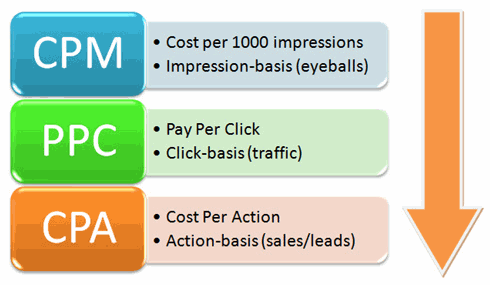There are several ways to conduct online advertising campaigns. You can pay search engines or other Internet publishers hosting your ads each time one of your ads is clicked, every 1,000 times the ad is seen, or every time the ad prompts a more sales-related action.
The third option entails a user clicking on your ad and signing up for a free trial of a product, registering for a free download, or buying your product. Signups and registrations generate company leads, while sales generate immediate cash in your pocket.
With this type of advertising you pay the host an agreed-upon fee for each specified type of action. For leads that can mean a set amount, while for sales that can mean a set percentage of the sale amount.
This method of online advertising is called “cost per action” (CPA). It can also be referred to as cost per acquisition, “pay per action” (PPA) or performance-based advertising.
How can cost per action advertising benefit advertisers?
Cost per action advertising generally involves less risk for advertisers than other advertising techniques. Since you only pay when you get a lead or a sale, you are protecting yourself from potential eyeballs that won’t convert, as well as click fraud. Those possibilities can put a dent in your pocketbook fast.
At the same time, you are ensuring that you only pay when you have money coming in, or when the prospect for money coming in is relatively great.
How can cost per action hurt advertisers?
You can actually lose money from a cost per action campaign if you have a low leads to sales ratio. This is because you may be paying publishers more for leads than you are generating from sales revenue.
That may be worth your while if you have a plan for converting more leads to sales or believe that the advertising exposure outweighs any current loss in revenue.
If you are losing money, you can try negotiating a lower cost per action fee from the publishers hosting your ads. Or you can switch over to a CPA campaign based on sales. Either way, know that your success at conversions can impact your ability to find a publisher willing to run your ad on a cost per action basis.
Why might publishers not want to run my ad on a cost per action basis?
If you don’t have a strong track record for the specified type of action, publishers may determine they’re better off hosting ads with more potential for bringing them revenue.
Google offers a cost per action advertising program where ads are placed on Google’s affiliate websites. But to qualify for the program, advertisers must prove they manage a site that attracts a desirable audience, has enough conversions, and makes enough money. The exact criteria may differ from advertiser to advertiser.
Other affiliate networks may also pass you by due to your track record or finances. Affiliate networks like LinkShare, PeerFly, and Affiliate.com ask about such topics as online revenues, monthly marketing budgets, and cost per action offers in their online advertising applications.
You may find that individual companies have more lenient criteria for doing business.
You can also build your own affiliate network by handpicking company websites you are interested in advertising on, and reaching out to the sites about potential cost per action opportunities.
How much should I pay per action?
While it is ultimately up to a publisher to accept or reject your offer, you should go into cost per action negotiations with a figure in mind. It’s important to do some homework when determining how much you are willing to spend per action.
For example, if you are already involved with a cost per click or cost per impression campaign, you should figure out how much you are paying for each conversion, whether it is a lead or sale. You can determine this amount by using an online cost per action calculator, like the one offered by ClickZ.
To get your cost per action you must enter either your cost per 1,000 impressions or cost per click, your conversion rate, and, if it’s a cost per impression campaign, your click through rate. You can get this information from within your pay per click account or a web analytics tool.
Once you have your current cost per action, you should try using a lower cost per action for a cost per action campaign.
Then what should I do?
Over time, evaluate how return on investment (ROI) from your CPA campaign compares with the ROI on your cost per impression or cost per click campaigns. If you have a much better return on investment for the cost per action campaign, you should consider scrapping the cost per impression or CPC campaign.
But if you have a much better return on investment for the cost per impression or cost per click campaign, you should probably negotiate a different cost per action amount or reconsider the CPA campaign.
If some of your products or services do better with one campaign type and others with another type, you can diversify your advertising methods.
Photo credit: http://www.flickr.com/photos/sepblog/3570992970/



0 Comments